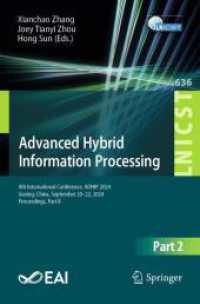- ホーム
- > 洋書
- > 英文書
- > Computer / General
Full Description
The proliferation of social media such as real time microblogging and online reputation systems facilitate real time sensing of social patterns and behavior. In the last decade, sensing and decision making in social networks have witnessed significant progress in the electrical engineering, computer science, economics, finance, and sociology research communities. Research in this area involves the interaction of dynamic random graphs, socio-economic analysis, and statistical inference algorithms.
Interactive Sensing and Decision Making in Social Networks provides a survey, tutorial development, and discussion of four highly stylized examples of sensing and decision making in social networks: social learning for interactive sensing; tracking the degree distribution of social networks; sensing and information diffusion; and coordination of decision making via game-theoretic learning.
Each of the four examples is motivated by practical examples, and comprises of a literature survey together with careful problem formulation and mathematical analysis. Despite being highly stylized, these examples provide a rich variety of models, algorithms and analysis tools that are readily accessible to a signal processing, control/systems theory, and applied mathematics audience.
Contents
1. Introduction and Motivation 2: Social Learning Approach to Interactive Sensing 3: Tracking Degree Distribution in Dynamic Social Networks 4: Sensing with Information Diffusion in Complex Social Networks 5: Non-Cooperative Game-Theoretic Learning 6: Summary. Acknowledgements. Appendices. References.








